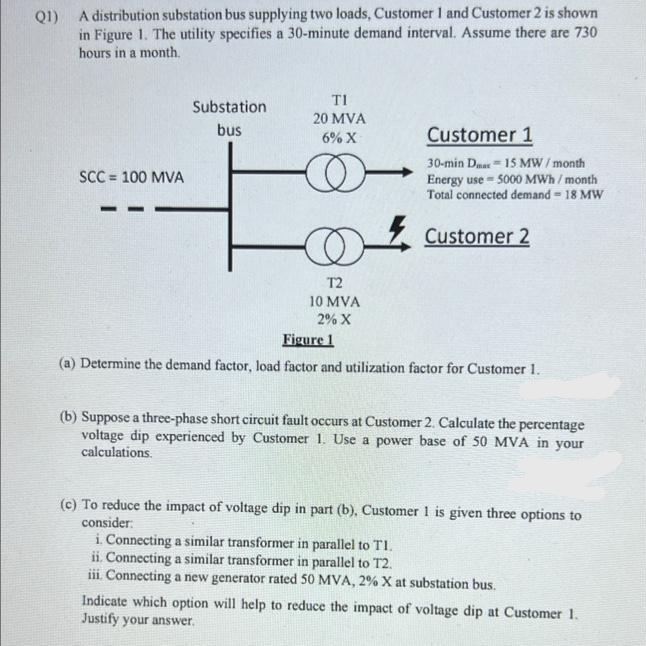A distribution substation bus supplying two loads, Customer I and Customer 2 is shown in Figure 1. The utility specifies a 30-minute demand interval. Assume there are 730 hours in a month. TI Substation 20 MVA bus 6% X Customer 1 30-min Dua = 15 MW / month SCC = 100 MVA Energy use - 500 MWh / month Total connected demand = 18 MW Customer 2 T2 10 MVA 2% X Figure 1 a) Determine the demand factor, load factor and utilization factor for Customer 1.
A distribution substation bus supplying two loads, Customer I and Customer 2 is shown in Figure 1. The utility specifies a 30-minute demand interval. Assume there are 730 hours in a month. TI Substation 20 MVA bus 6% X Customer 1 30-min Dua = 15 MW / month SCC = 100 MVA Energy use - 500 MWh / month Total connected demand = 18 MW Customer 2 T2 10 MVA 2% X Figure 1 a) Determine the demand factor, load factor and utilization factor for Customer 1.
Introductory Circuit Analysis (13th Edition)
13th Edition
ISBN:9780133923605
Author:Robert L. Boylestad
Publisher:Robert L. Boylestad
Chapter1: Introduction
Section: Chapter Questions
Problem 1P: Visit your local library (at school or home) and describe the extent to which it provides literature...
Related questions
Question

Transcribed Image Text:Q1) A distribution substation bus supplying two loads, Customer 1 and Customer 2 is shown
in Figure 1. The utility specifies a 30-minute demand interval. Assume there are 730
hours in a month.
TI
Substation
20 MVA
bus
Customer 1
6% X
30-min Dmar- 15 MW/ month
Energy use - 500 MWh / month
Total connected demand = 18 MW
SCC = 100 MVA
Customer 2
T2
10 MVA
2% X
Figure 1
(a) Determine the demand factor, load factor and utilization factor for Customer 1.
(b) Suppose a three-phase short circuit fault occurs at Customer 2. Calculate the percentage
voltage dip experienced by Customer 1. Use a power base of 50 MVA in your
calculations.
(c) To reduce the impact of voltage dip in part (b), Customer 1 is given three options to
consider:
i Connecting a similar transformer in parallel to TI.
ii. Connecting a similar transformer in parallel to T2.
iii. Connecting a new generator rated 50 MVA, 2% X at substation bus.
Indicate which option will help to reduce the impact of voltage dip at Customer 1.
Justify your answer.
Expert Solution
This question has been solved!
Explore an expertly crafted, step-by-step solution for a thorough understanding of key concepts.
Step by step
Solved in 2 steps

Knowledge Booster
Learn more about
Need a deep-dive on the concept behind this application? Look no further. Learn more about this topic, electrical-engineering and related others by exploring similar questions and additional content below.Recommended textbooks for you

Introductory Circuit Analysis (13th Edition)
Electrical Engineering
ISBN:
9780133923605
Author:
Robert L. Boylestad
Publisher:
PEARSON

Delmar's Standard Textbook Of Electricity
Electrical Engineering
ISBN:
9781337900348
Author:
Stephen L. Herman
Publisher:
Cengage Learning

Programmable Logic Controllers
Electrical Engineering
ISBN:
9780073373843
Author:
Frank D. Petruzella
Publisher:
McGraw-Hill Education

Introductory Circuit Analysis (13th Edition)
Electrical Engineering
ISBN:
9780133923605
Author:
Robert L. Boylestad
Publisher:
PEARSON

Delmar's Standard Textbook Of Electricity
Electrical Engineering
ISBN:
9781337900348
Author:
Stephen L. Herman
Publisher:
Cengage Learning

Programmable Logic Controllers
Electrical Engineering
ISBN:
9780073373843
Author:
Frank D. Petruzella
Publisher:
McGraw-Hill Education

Fundamentals of Electric Circuits
Electrical Engineering
ISBN:
9780078028229
Author:
Charles K Alexander, Matthew Sadiku
Publisher:
McGraw-Hill Education

Electric Circuits. (11th Edition)
Electrical Engineering
ISBN:
9780134746968
Author:
James W. Nilsson, Susan Riedel
Publisher:
PEARSON

Engineering Electromagnetics
Electrical Engineering
ISBN:
9780078028151
Author:
Hayt, William H. (william Hart), Jr, BUCK, John A.
Publisher:
Mcgraw-hill Education,